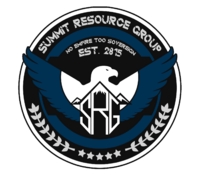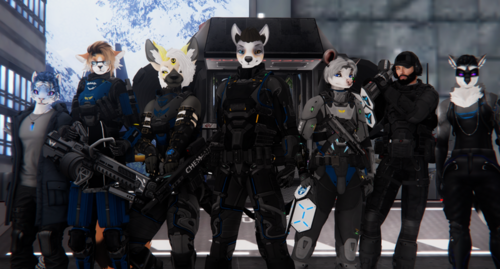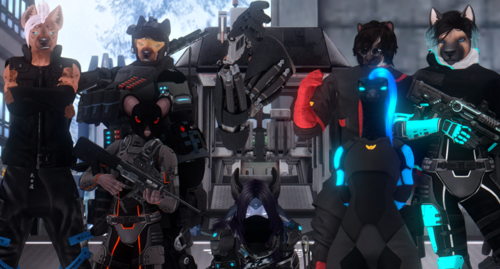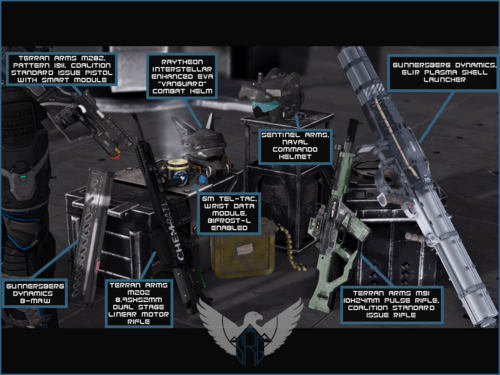NOTICE
The lore articles on the wiki are currently being rewritten in some capacity. If you wish for the most updated information, or knowledge on a specific article, the best place to reach out is in #sim-lore-general on Discord.
Summit Resource Group
Out of the ashes of the Secession War, Summit Resource Group was founded. Lead by former Solar Legionnaire, it called to its eagle sigil some of the thousands of soldiers and sailors who'd been trapped by the Shattering. As the FTL routes started to be repaired, Summit Resource Group rapidly became the Coalition's go to choice for operations within restricted space, holding over two-hundred and twenty nine separate operations contracts with various ISTO bodies by 2820. Their most recent venture has been to the Miranmir System, tasked with looking after the Coalition & Directorates interests in the system. A twelve strong flotilla was dispatched in 2821 to reinforce the already present diplomatic security force. The reasons for such a substantial deployment are multiple. Artifacts, Federal Guard activity, desire to maintain the status quo. All of these will form part of SRG's mission out on the edge. Needless to say, if history has shown us anything, such a large group of the Coalitions finest corporate soldiers and sailors will cause reverberations that could be felt all the way back in the core.
— R. K. Kliens , Janes Interstellar, Issue 2821-7
| Summit Resource Group | ||
|---|---|---|

| ||
| Application | ||
| Leadership | ||
| Faction Leader | Solomon Kore (Huttser Ishelwood) | |
| Senior Staff | Zane St.Claire, Deputy Commander (Sol Krovac)
Fitz McTavish, Deputy Commander (Grimm Hexem) Phillip Aubin, Operations Director (Phillip Aubin) Smiley Dyrssen, Research Director (Smiley Dyrssen) Tahikida Arcamenel, Fleet Director (Tahikida) | |
| Information | ||
| Alignment | Lawful Neutral | |
| Type | Coalition Backed Private Military Group | |
| Headquarters | Restricted Military Instaliation, Starport | |
Overview
Founded as a response to the withdrawl of Galactic Coalition forces from the White Belt following The Secession War, Summit Resource Group (SRG) has developed considerable experience in operating in the most austere environments in the galaxy. Seamlessly integrating security, logistics, insurance, intelligence and both physical and digital infrastructure for customized solutions, it works with its clients to overcome complex and unique challenges to defend the Coalition and her allies.
The men and women of SRG operate under one very simple rule. Do nothing to endanger the mission, all else is discretionary. It is this mindset that sets them apart from their more law enforcement minded colleagues. If something threatens the interests or citizens of the Galactic Coalition, or wider interstellar security, they will intervene by any means necessary.
Miranmir Operations
SRG operates out of three main locations in the Miranmir System. The Galactic Coalition Consulate in Dusklight, a major base out in the Frontier and their flotilla of starships in high orbit.
The group has two primary contracts. The first and it's main responsibility, often referred to as "the mission" is with the Galactic Coalition. It tasks them with two delicate missions. One, of securing precursor artifacts within WBA jurisdiction, more specifically, Miranmir, preventing the transfer of these dangerous, yet-to-be understood items into the hands of anyone other then the Coalition. Two, the degradation of the Federation's influence and operations in Miranmir, all whilst operating within the confines of the White Belt Accords.
SRG is also holds a second contract, from the White Belt Administration to secure Dusklights critical infrastructure, starport and orbital space. SRG operators perform rapid response and counter assault duties in response to threats to any of these locations, with law enforcement duties and follow up left to RSS.
Who does SRG look for?
Summit Resource Group looks for individuals from a wide array of backgrounds. Scientists, medics, novices, and seasoned operators alike. Whilst former military experience is a bonus, it is by no means required. SRG provides training and equipment as needed. Courage, passion, initiative, and decisiveness are the ideal qualities the the group looks for as their staff are often be expected to operate alone or in small teams to execute operations in austere environments with little support.
Values
Summit Resource Group. It is an ethos and an employer at the same time. It intends to embody the key founding values of the Galactic Coalition; Loyalty, Freedom, Diversity, and Security. The same values that safeguard the citizens of the Galactic Coalition help them succeed in the darkest and harshest corners of space.
Organizational Structure
SRG is formed of the command group, four distinct Directorates, and three support units. Directorates are joint formations that handle tasks that require cross cutting support from all SRG elements, SRG personnel will likely find themselves permanently assigned to one Directorate or another. Support Units have very specific mission roles which are typically extra roles, ontop of other responsibilities.
| Role | Type | Officers Responsible | Current Holders | Duties |
|---|---|---|---|---|
| Command Group | Directorate | Commander, SRG | CMDR S. Kore
(Huttser Ishelwood) |
Consisting of all the senior officers in system, it is this collection of staff that advises the Commander and charts the strategic direction of SRG |
| Consulate Staff | Support Unit | Consulate Chief-of-Staff | CoS Garl Waru
(Reticently) |
Staff working for the current Coalition military representatives on planet, handling a variety of duties, such as Liason officers, Consular Officers, Private Secretaries, Internal Security etc |
| Operations | Directorate | Operations Director | DIR Phillip Aubin
(Phillip Aubin) |
Oversees all ground activities of SRG, including offensive operations, atmospheric air support, engineering, security deployments and support task forces. |
| Research | Directorate | Research Director | DIR Smiley Dyrssen
(Smiley Dyrssen) |
The Research Directorate covers the full range of possible disciplines, with a focus on artifact. psionics and precursor studies |
| Fleet | Directorate | Fleet Director & Ship Commanders | DIR Tahikida Arcamenel
(Tahikida) |
Responsible for ensuring the maintainance and delivery of fleet support to SRG's operations in the Miranmir system. |
| Medical | Directorate | Chief Medical Officer/Medical Director | -Vacant- | Ensuring the health of the entire group is kept to the highest level. The Medical Directorate co-ordinates the work of SRGs doctors, combat medics and researchers when it comes to force health. |
| Supply Staff | Support Unit | Quartermaster | QM Rikard T'Katan
(Grimm Hexem) |
Supply Staff equip SRG's forces, and maintain a high stock level of all consumables the force could ever need to call on. |
| Special Mission Unit | Support Unit | Special Mission Co-ordinator | SO Eldrinn M'Carda
(Eldrinn) |
An ad-hoc mission team assembled for tasks, at the direction of Commander SRG, that require exceptional levels of discretion. |
Ranks
SRG's ranks are split into three major groups. Leadership, the two senior officers responsible for all operations. The Command Group, who oversee specific mission areas. Then the personnel, who enact the orders of the command group and execute SRG's Mission.
| Rank | Responsibilities | |
|---|---|---|
| Leadership | Commander | The Commander is SRGs head in system. Responsible for charting the strategic direction of the group, and reporting to their Coalition masters. |
| Deputy Commander | The Deputy Commander manages those stationed upon vessels or bases run and managed by the SRG. They deputise for the commander as required. | |
| Command Group | Directors | Directors may oversee planetary-wide operations and form part of the command group alongside the Commander and Deputy Commander. They will also hold responsibility for one of the four directorates: Operations, Research, Fleet or Medical. |
| Staff Officers | Staff Officers oversee the day to day running of SRG. This allows the rest of the command group to focus on long term planning and operational delivery. During operations they will often lead teams of Operators under a Director, Deputy Commander or Commander. | |
| Personnel | Veterans | The Veteran role is held by those who have a specific duty or who have served SRG with distinction. They most often have access to higher access material that relates to their field. They may also regularly train new members of the SRG in field skills or personally head up missions. Veterans can come from any of the three entry ranks. |
| Operators | Frontline employees. The main entry point for SRG. Handling combat operations and security for other elements of the force. | |
| Researchers | Staffing SRG's considerable Research ships and underground labs, this entry point for SRG covers all those with a more academic lean. | |
| Staff | These are employees that have been cleared to act on behalf of the organization in fulfilment of the mission. They typically don't hold combat roles. |
Faction Relations
SRG by and large operates to maintain the status quo established by the White Belt Accords, atleast on the surface of things. They do not seek to overturn the governance of the system, but do hold a wilful disregard for their authority, seeing their mission, provided to them by the Galactic Coalition as superior to the WBA's own. That mission often involves projecting Coalition interests, security precursor artfacts or countering Federal (and wider Jingashi Concordant) efforts. This often brings them into direct conflict with groups operating in the same spheres. With regards to corporations, SRG is wholy supportive of most corporate entites, so long as they are Coalition aligned, as evdienced by their close relationship with the Shock Trauma Armed Rescue Service.
| Faction | Relationship | Details |
|---|---|---|
| STAG - Executive | Positive | |
| STAG - GR | Positive | |
| STAG - RSS | Neutral | |
| STAG - STARS | Positive | |
| House Ajnoria | Hostile | |
| OSIRIS Network | Negative | |
Equipment
Armored Combat Void Suits
As an orbitally deployed force that has to account for hot drops from dropships, ship to ship boarding actions and ground deployments in a hostile frontier, members of Summit Resource Group (SRG) have access to a variety of armored combat void suits (ACVS). These are sealed, protective suits with self-contained rebreathers that allow the operator to perform combat operations in hazardous environments, such as the vacuum of space. The beefier, more expensive and heavily armored cousin to the standard “ship suit” that has become ubiquitous throughout the territory of the space borne powers, combat void suits are often equipped with magnetic boots and gloves, tether lines and a whole host of automated sensors designed to inform the wearer about their environs.
More restrictive than standard ship suits, ACVS are substantially better armored and often contain improved system core firmware, enabling them to interface with a wider selection of additional military hardware and software packages. They represent a paradigm shift in armor concepts, using ultra-modern, flexible, fluid Armor plates and hardened smart armorweave fibers to provide primary layers of protection, rather than purely relying on interceptor vests or clamshell armored chest plates. Despite the baseline protection, this doesn’t preclude operators from augmenting their protection with further chest, arm and leg armor, on top of their ACVS. Further rigging can also be worked over the suit to allow personnel to carry more gear. The smart elements of the armorweave skin of these suits can often be reconfigured into various camouflage colors, but operators tend to keep the standard black and Prussian blue.
Whilst standard patterns of ACVS exist, operators have been granted a large amount of leeway in purchasing, developing, fabricating and customizing their own suit. This has led to the ACVS becoming as much a standard as a product.
Frontier Duty Uniform
Introduced to address concerns of some operators regarding unnecessary wear and tear on ACVS outside of environmental hazard areas. This more comfortable clothing option, the Frontier Duty Uniform is based on the Coalitions Interstellar Duty Uniform. Fabricated from a robust yet light nanoweave fabric, the base uniform, either in black or multicam provides a very basic level of protection, thermal regulation and signature reduction. This is often augmented with standard issue “vanguard” armor systems, covering the torso, shoulders and shins.
Whilst the Frontier Duty Uniform isn’t rated for void operations, when coupled with appropriate boots, gloves and enclosed helmet, it can provide a time limited element of sealed protection from vacuum and other hazardous elements.
Small Arms
SRG has no standardized weapon policy. Affording it's operators an element of tactical flexibility to deploy whatever weapon system they deem tactically and operationally prudent. However it does maintain a sizeable cache of "standardized" weapons, most drawn from the Coalition armories made by Terran Arms Inc. As a sidearm, it uses the M282 Pulse Pistol, the Coalition's standard issue sidearm. Modeled after the venerable 1911 but packed with 29th century technology and chambered in 10mm caseless. For a rifle, the M91 Pulse Rifle, chambered in 10x244mm caseless, this rifle has served both the Navy and Marines as their primary battlefield weapon for the last ten years. Highly modular, the M91 can be configured as a PDW, Carbine, Assault Rifle, Marksman Rifle or even configured to fire rocket assisted ammo. The M91 is also distinctive for the "slapping" motion possible when charging the weapon. Although most manuals suggest using the bolt release. Finally, in the small arms category, the Coalition Armies standard battle rifle, the M202 Dual Stage Linear Motor Rifle or DSLMR. Desiring something with more stopping power then the M91, the M202 fires 8.75x52mm sabot's that are first chemically launched, then accelerated by electromagnetic coils delivering exceptionally high muzzle velocities capable of punching through most, if not all modern battlefield armor.


